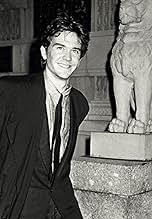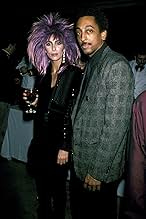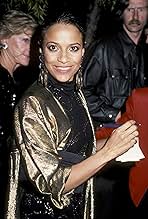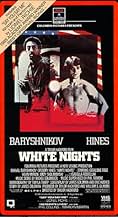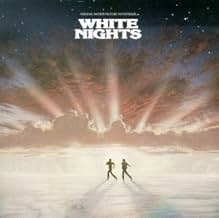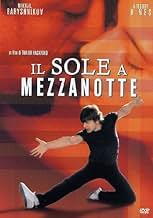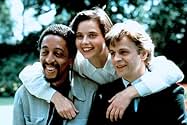El avión de un bailarín de ballet ruso-estadounidense se ve obligado a aterrizar en la URSS, donde es "repatriado". Se aloja con un estadounidense que está casado con una rusa. ¿Le ayudará a... Leer todoEl avión de un bailarín de ballet ruso-estadounidense se ve obligado a aterrizar en la URSS, donde es "repatriado". Se aloja con un estadounidense que está casado con una rusa. ¿Le ayudará a huir de la URSS?El avión de un bailarín de ballet ruso-estadounidense se ve obligado a aterrizar en la URSS, donde es "repatriado". Se aloja con un estadounidense que está casado con una rusa. ¿Le ayudará a huir de la URSS?
- Dirección
- Guionistas
- Elenco
- Ganó 1 premio Óscar
- 3 premios ganados y 2 nominaciones en total
Opiniones destacadas
The movie is imaginative - having Gregory Hines in a theater in Siberia, a defector to Russia when disillusioned and unable to find use for his talents as an adult tap dancer in America after the Vietnam War, married to the translator initially assigned him (an astonishing peformance by Isabella Rosellini), and performing Porgy & Bess to audiences including Russian troops - well, it's a character and situation you don't find in movies every day!
I was amazed at the close-knit work of actors who were not then first name movie stars - and at how well-drawn these characters are -
Helen Mirren is superb as Baryshnikov's former lover, partner, and now director of the Kirov Ballet - angry and constantly deluding herself that things are getting more artistically free in Russia -
Baryshnikov is excellent, reliving the pain of defection in his old theater, seeing a tape of himself when at 17 he was care-free and full of illusory ambition, the discovery of the erasure of his name among children in Russia, the anger of his former partner for his abandonment of her and denunciation of his "selfishness" in defecting -
Hines as a man living with an atrocious mistake and trying always to justify itself to himself - in Siberia, he seems like a man on Mars -
an almost unrecognizable Rosellini as a Russian woman in pained love with Hines (just the looks on her face of love and sympathy and pity and helplessness for Hines are so powerful and moving - I'll never forget them)-
the four are so very very fine together. Each TRULY seems the person they're portraying. If one were to see news photographs or a documentary about such characters - they would look this way, sound this way, move and speak and dress this way.
The dancing is very enjoyable to watch - and you really needn't be a fan of dance (I'm not) to marvel at it.
The only downside of the movie is that it takes these four fascinating and pained characters, and stuffs them into a somewhat formulaic action plot. I also found the music too heavy throughout - let there be silences as they contemplate their messy situations.
This is very well worth seeing.
Gregory Hines is a good second-lead (and has been much underused in films since), providing a sparring partner for Baryshnikov both in dance - as jazz/tap dancer vs ballet dancer - and to the benefit of the script. Isabella Rosselini plays a damsel in distress, complementing the duo and providing the romantic angle, balancing the story-line.
Overall it is a well-made film, though not the best ever, and if your interest lies about as far afield from dance as the local football field it is unlikely to appeal. But for anyone wanting to see a romantic 'weepie' it can provide a good slice of entertainment for a Sunday afternoon. And as for the dancing ... well, Baryshnikov was 37 then and I have never seen such athleticism and agility in a dancer of that age. Such expressive emotions come through his steps that he needs no words.
Without the dancing the film would undoubtedly have lost its true winning power, but with it may well have provided the motivation to dance for both children and adults ... I hope you enjoy it as much as I have
9 years later it is remains one of my top 20 best films.
The camera work here is among the most original and clever out there. It's incredibly dynamic and energetic, offering unusual perspectives, delivering great close-ups, and skillfully capturing the sweeping wide spaces. An unusually large amount of footage is devoted to the city landscapes of St. Petersburg - a rarity in American flicks on Russian themes. It's all the more jarring, however, that despite attempts to ensure authenticity of the setting, at least the first couple of car rides seem to have been done in a stationary vehicle and plastered rather crudely against the city background. But this is a forgivable and almost charming flaw, considering the film's limited budget and the release year of 1985.
The film is a paradox of sorts, showcasing interesting performances from Rossellini and Hines, two actors who have since been totally under-appreciated. There's good chemistry between the impressionable and high-strung duet of Darya and Raymond. Jerzy Skolimovski (Colonel Chaiko) is the classical cunning villain with a Slavic flare. Baryshnikov himself seems a bit rigid and somewhat formulaic as Nikolay Rodchenko. That is when he's not dancing, of course. For when he dances, he unleashes all imaginable and unimaginable potential.
Obviously, the story line is sketched out in broad, exaggerated strokes. But I bet the filmmakers actually expected the overall theatricality to be taken with a grain of salt. Besides, the subject matter discussed wasn't keen on subtleties. The events depicted were behind-the-scenes operations all right, but they were as blunt and theatrically bizarre as can be. And as for those who think the circumstances and emotions of the dissidence and emigration (or defection in this case) experience are overblown - brush up on mid-20th century history and get a grip on things. Not only had the Big Brother's machinery of state control and suppression been well oiled for decades in the Soviet Union and its satellites, but the shadow of this absurd, merciless beast hangs over many of those nations still. Folks, the fictionalized account of Nikolay Rodchenko is merely a -slightly- glamorized and dramatized version of real life experience of countless victims of the era.
The scenes of Nikolay and Darya fleeing through the deserted streets of Leningrad and the subsequent humiliation they experience in front of the American embassy send chills down my spine every time I watch the movie. That threat and that danger are very real to me even though my emigration experience in the 1990s was simply peachy in retrospect and comparison. Just as disturbing and sobering, by the way, is Rodchenko's reception by the Americans and the so-called international community inside the gates. He to them is but a nimble exotic specimen...
Anyhow, let me dismount my high horse and reiterate, seconding the earlier reviews, that `White Nights' features superb, matchless dancing; and, to miss it is a deathly sin. Well, almost...
There are essentially four dance highlights in the movie. Choreography is mainly by Baryshnikov, Hines, and, very importantly, Twyla Tharp. Baryshnikov's duet with Florence Faure in the opening credits is bound to leave your breathless. It is sheer perfection - immensely inventive and impeccably executed. The second instance when you'll forget that you could blink and breathe is during the 11 rubles for 11 pirouettes number. He does it with a godly effortlessness. Hines' and Baryshnikov's dance studio number is fascinating to watch. And, then Then, there's Mikhail's solo to Vysotsky's tape on the stage of the Kirov theatre. Its beauty is literally painful and words can never describe it.
If you haven't seen `White Nights' or haven't seen it more than once, you're denying yourself an unearthly pleasure. And you can snicker at my high-flown sighs and exclamations all you want :)
¿Sabías que…?
- TriviaMikhail Baryshnikov reportedly was insistent with the producers that gramatically-correct Russian be spoken in this movie instead of the often nonsensical hybrid often used in American movies. Baryshinkov also did a scene where he spoke French. In real life, it was his second language.
- ErroresContrary to the title of the film, White Nights describes the continuous daylight in regions along the Arctic Circle, the moments at the end of the film show the characters engulfed in complete darkness outside the consulate. This would not have happened in Leningrad (now Saint Petersburg) between May and August.
- Citas
Pilot: [over the P.A] Ladies and gentlemen, may I have your attention, please? This is the Captain speaking. We have developed electrical problems, and we have to land immediately. There is a Soviet military airfield about 75 miles from here...
Anne Wyatt: [half asleep] Where are we? Are we landing?
[Kolya runs to the lavatory to destroy his identity papers]
Anne Wyatt: Where are you going?
Nikolai 'Kolya' Rodchenko: What do you mean? We're landing in Russia!
- Versiones alternativasThe UK cinema release was cut by 16s to remove two uses of 'fuck' to earn a PG rating. Subsequent video versions restore the strong language and raise the certificate to 15.
- ConexionesFeatured in At the Movies: The Holcroft Covenant/Bring on the Night/Target (1985)
- Bandas sonorasSeparate Lives
(Love Theme)
Written by Stephen Bishop
Produced by Arif Mardin, Phil Collins, and Hugh Padgham
Performed by Phil Collins and Marilyn Martin
Courtesy of Atlantic Records and Virgin Records
Selecciones populares
Detalles
- Fecha de lanzamiento
- País de origen
- Sitio oficial
- Idiomas
- También se conoce como
- White Nights - Nacht der Entscheidung
- Locaciones de filmación
- Parainen, Finlandia(Exterior)
- Productoras
- Ver más créditos de la compañía en IMDbPro
Taquilla
- Presupuesto
- USD 20,000,000 (estimado)
- Total en EE. UU. y Canadá
- USD 42,160,849
- Fin de semana de estreno en EE. UU. y Canadá
- USD 477,539
- 24 nov 1985
- Total a nivel mundial
- USD 42,160,849
- Tiempo de ejecución2 horas 16 minutos
- Color
- Relación de aspecto
- 1.85 : 1
Contribuir a esta página




